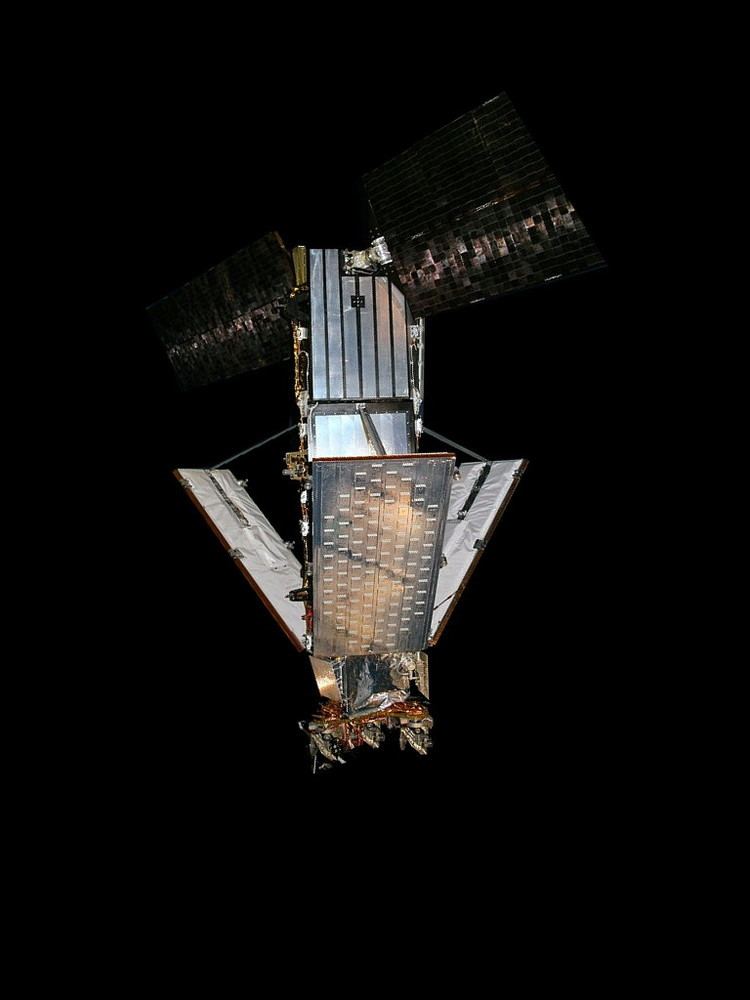 | ||
The 2009 satellite collision was the first accidental hypervelocity collision between two intact artificial satellites in low Earth orbit. It occurred on February 10, 2009, 16:56 UTC, when Iridium 33 and Kosmos-2251 collided at a speed of 42,120 km/h (11.70 km/s; 26,170 mph) and an altitude of 789 kilometres (490 mi) above the Taymyr Peninsula in Siberia.
Contents
Spacecraft
Kosmos-2251 was a 950-kilogram (2,094 lb) Russian Strela military communications satellite. It was launched on a Russian Kosmos-3M carrier rocket on June 16, 1993. It had been deactivated prior to the collision, and remained in orbit as space debris. Iridium 33 was a 560-kilogram (1,235 lb) commercial US-built satellite and was part of the commercial satellite phone Iridium constellation of 66 communications satellites. It was launched on September 14, 1997, atop a Russian Proton rocket.
Collision
The collision destroyed both Iridium 33 (owned by Iridium Communications Inc.) and Kosmos 2251 (owned by the Russian Space Forces). The Iridium satellite was operational at the time of the collision. Kosmos-2251 was launched on June 16, 1993, and went out of service two years later, in 1995, according to Gen. Yakushin. It had no propulsion system, and was no longer actively controlled.
Several smaller collisions had occurred previously, during rendezvous attempts or the intentional destruction of a satellite, including the DART satellite colliding with MUBLCOM, and three collisions involving the manned Mir space station, during docking attempts by Progress M-24, Progress M-34, and Soyuz TM-17, but these were all low-velocity collisions. In 1996, the Cerise satellite collided with space debris. There have been eight known high-speed collisions in all, most of which were only noticed long after they occurred.
Fallout
U.S. space agency NASA estimated that the satellite collision created approximately 1,000 pieces of debris larger than 10 centimeters (4 inches), in addition to many smaller ones. By July 2011, the U.S. Space Surveillance Network had cataloged over 2000 large debris fragments. NASA determined the risk to the International Space Station, which orbits about 430 kilometres (270 mi) below the collision course, to be low, as was any threat to the shuttle launch (STS-119) then planned for late February 2009. However, Chinese scientists have said that the debris does pose a threat to Chinese satellites in Sun-synchronous orbits, and the ISS did have to perform an avoidance maneuver due to collision debris in March 2011.
By December 2011, many pieces of debris were in a steady orbital decay towards Earth, and expected to burn up in the atmosphere within one or two years. By January 2014, 24% of the known debris had decayed. In 2016, Space News listed the collision as the fourth biggest fragmentation event in history, with Iridium 33 producing 628 pieces of cataloged debris, of which 364 pieces of tracked debris remain in orbit as of January 2016.
A small piece of Kosmos 2251 satellite debris safely passed by the International Space Station at 2:38 a.m. EDT, Saturday, March 24, 2012. As a precaution, the six crew members on board the orbiting complex took refuge inside the two docked Soyuz rendezvous spacecraft until the debris had passed.
A number of reports of phenomena in the US states of Texas, Kentucky, and New Mexico were attributed to debris from the collision in the days immediately following the first reports of the incident in 2009, although NASA and the United States Strategic Command, which tracks satellites and orbital debris, did not announce any reentries of debris at the time and reported that these phenomena were unrelated to the collision. On February 13, 2009, witnesses in Kentucky heard sonic booms. The National Weather Service issued an information statement alerting residents of sonic booms due to the falling satellite debris. The Federal Aviation Administration also released a notice warning pilots of the re-entering debris. Some reports include details that point to these phenomena being caused by a meteoroid shower. A very bright meteor over Texas on February 15, 2009, was mistaken for reentering debris.
Cause
Events where two satellites approach within several kilometers of each other occur numerous times each day. Sorting through the large number of potential collisions to identify those that are high risk presents a challenge. Precise, up-to-date information regarding current satellite positions is difficult to obtain. Calculations made by CelesTrak had expected these two satellites to miss by 584 meters.
Planning an avoidance maneuver with due consideration of the risk, the fuel consumption required for the maneuver, and its effects on the satellite's normal functioning can also be challenging. John Campbell of Iridium spoke at a June 2007 forum discussing these tradeoffs and the difficulty of handling all the notifications they were getting regarding close approaches, which numbered 400 per week (for approaches within 5 km) for the entire Iridium constellation. He estimated the risk of collision per conjunction as one in 50 million.
This collision and numerous near-misses have renewed calls for mandatory disposal of defunct satellites (typically by deorbiting them or at minimum sending them in graveyard orbit), but no such international law exists yet. Nevertheless, some countries have adopted such a law, such as France in December 2010. The United States Federal Communications Commission (FCC) requires all geostationary satellites launched after March 18, 2002, to commit to moving to a graveyard orbit at the end of their operational life.
